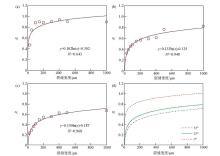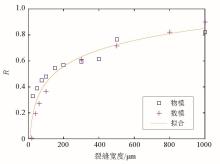|
|
|
| Studies on the effec of crack on the propagation of acoustic waves in wellbore |
Li LIU1, Cheng-Guang ZHANG1( ), Ming CAI1, Yang HE1, Yu-Jin HUA2, Yu LIU3 ), Ming CAI1, Yang HE1, Yu-Jin HUA2, Yu LIU3 |
1. Key Laboratory of Exploration Technologies for Oil and Gas Resources, Ministry of Education,Yangtze University,Wuhan 430100,China
2. College of Mining Engineering,Taiyuan University of Technology,Taiyuan 030024,China
3. School of Geophysics Measurement-control Technology,East China University of Technology,Nanchang 330013,China |
|
|
|
|
Abstract In tight oil and gas reservoirs,cracks are important seepage channels and reservoir spaces for hydrocarbon migration.The development of the crack directly controls the reservoir performance.In order to evaluate the crack development by using the shear and Stoneley wave attenuation information,the authors used the three-dimensional variable grid time domain finite difference method to study the influence of crack widths and angles on shear and Stoneley wave attenuation in the wellbore environment.The results show that,as the crack width increases,the transmitted Shear wave and the Stoneley wave undergo energy decay.When the crack is tilted,the transmission Stoneley wave is insensitive to the crack dip.As the dip angle becomes larger,the attenuation does not change much.However,the transmitted shear wave is more sensitive to the crack dip.When the crack dip angle is 0°,the transmitted shear wave attenuation amplitude is the largest.As the dip angle of the crack becomes larger,the attenuation of the transmitted shear wave becomes significantly smaller.When the crack dip angle is greater than 25°,the attenuation amplitude of the transmitted shear wave becomes smaller and smaller as the angle increases.In addition,the numerical simulation of the shear wave attenuation curve is compared with the shear wave attenuation curve in the physical experiment, and the two are in good agreement.This study has a certain theoretical guidance for improving the acoustic logging evaluation method of fractured reservoirs.
|
|
Received: 13 May 2019
Published: 28 November 2019
|
|
|
|
Corresponding Authors:
Cheng-Guang ZHANG
E-mail: zhangcg@yangtzeu.edu.cn
|
|
|
|

|
The hole model in a cracked formation
|

|
The variable grid difference schematic
|

| 弹性介质 | Vp/(m·s-1) | Vs/(m·s-1) | ρ/(kg·m-3) | | 5400 | 2905 | 2710.5 | | 井眼及裂缝流体 | Vp/(m·s-1) | Vs/(m·s-1) | ρ/(kg·m-3) | | 1500 | — | 1000 |
|
The parameters of the media
|

|
The comparison results of finite difference and real axis integration method
|

|
The waveform overlay of different crack widths
a—the crack dip angle of 0°;b—the crack dip angle of 25°
|

|
The relationship between crack width and Stoneley wave attenuation coefficient
a—the crack dip angle of 0°;b—the crack dip angle of 25°
|

|
The relationship between crack width and shear wave attenuation coefficient
a—the crack dip angle of 0°;b—the crack dip angle of 25°
|

|
The waveform comparison chart of different dip angles
|

|
TheStoneley wave attenuation curve with different dip angles
|

|
The shear wave attenuation curve with different dip angles
|

|
Drilling core
|

|
Waveform measurement device of small core
|

|
Arraywaveforms of small core with different crack width
|

|
Relationship between shear wave attenuation coefficient and crack width of core samples with different dip angles
a—the crack dip angle of 0°;b—the crack dip angle of 25°;c—the crack dip angle of 55°;d—a comprehensive analysis of the attenuation curves of different dip angles
|

|
The attenuation curve overlay
|
| [1] |
邓少贵, 袁习勇, 王正楷 , 等. 裂缝性地层方位侧向测井响应数值模拟[J]. 地球物理学报, 2018,61(8):3457-3467.
|
| [1] |
Deng S G, Yuan X Y, Wang Z K , et al. Numerical simulation of azimuthal laterolog response in fractured formation[J]. Chinese J. Geophys, 2018,61(8):3457-3467.
|
| [2] |
杨帆, 章成广, 范姗姗 . 利用斯通利波评价裂缝性致密砂岩储层的渗透性[J]. 石油天然气学报, 2012,34(4):88-92.
|
| [2] |
Yang F, Zhang C G, Fan S S . Evaluating the permeability of fractured tight sandstone reservoirs with stoneley wave[J]. Journal of Oil and Gas Technology, 2012,34(4):88-92.
|
| [3] |
阎守国, 谢馥励, 龚丹 , 等. 含有倾斜薄裂缝孔隙地层中的井孔声场[J]. 地球物理学报, 2015,58(1):307-317.
|
| [3] |
Yan S G, Xie F L, Gong D , et al. Borehole acoustic fields in porous formation with tilted thin fracture[J]. Chinese J. Geophys, 2015,58(1):307-317.
|
| [4] |
Paillet F L, White J E . Acoustic modes of propagation in the borehole and their relationship to rock properties[J]. Geophysics, 1982,47(8):1215-1228.
|
| [5] |
Hsu K, Brie A, Plumb R A. A new method for fracture identification using array sonic tools[C]// Presented at Ann. Conf.,Soc. Petr. Engr., 1985: 14397.
|
| [6] |
Winkler K W, Liu H L, Johnson D L . Permeability and borehole Stoneley waves: comparison between experiment and theory[J]. Geophysics, 1989,54(1):66-77.
|
| [7] |
章成广, 肖承文, 李维彦 . 声波全波列测井响应特征及应用解释研究[M]. 武汉: 湖北科学技术出版社, 2008.
|
| [7] |
Zhang C G, Xiao C W, Li W Y. Full wave acoustic logging response characteristics and application research of interpretation[M]. Wuhan: Hubei Science and Technology Press, 2008.
|
| [8] |
Hornby B E, Johnson D L, Winkler K W , et al. Fracture evaluation using reflected Stoneley-wave arrivals[J]. Geophysics, 1989,54(10):1274-1288.
|
| [9] |
Fan H, Smeulders D M J. Shock-induced Stoneley waves in fractured and permeable formations[C]// SEG Technical Program Expanded Abstracts, 2010: 558-562.
|
| [10] |
Fan H, Smeulders D M J . Open borehole shock-induced Stoneley waves in fractured formations and mandrel samples[C]// SEG Technical Program Expanded Abstracts, 2011: 459-463.
|
| [11] |
龚丹, 章成广 . 裂缝性致密砂岩储层声波测井数值模拟响应特性研究[J]. 石油天然气学报, 2013,35(7):82-86.
|
| [11] |
Gong D, Zhang C G . Research on Numerical simulation response characteristics of acoustic logging for fractured tight sandstone reservoirs[J]. Journal of Oil and Gas Technology, 2013,35(7):82-86.
|
| [12] |
Matuszyk P J, Torres-Verdín C, Pardo D . Frequency-domain finite-element simulations of 2D sonic wireline borehole measurements acquired in fractured and thinly bedded formations[J]. Geophysics, 2013,78(4):193-207.
|
| [13] |
Yuan M X, Pan B Z, Liu W B. Acoustic experimental measurement of fractured rocks and application to log evaluation of fractured reservoirs[C]// 2016 SEG Rock Physics & Borehole Geophysics Workshop, 2016: 73-76.
|
| [14] |
唐军, 章成广, 信毅 . 油基钻井液条件下裂缝声波测井评价方法:以塔里木盆地库车坳陷克深地区致密砂岩储集层为例[J]. 石油勘探与开发, 2017,44(3):389-397, 406.
|
| [14] |
Tang J, Zhang C G, Xin Y . A fracture evaluation by acoustic logging technology in oil-based mud:A case from tight sandstone reservoirs in Keshen area of Kuqa depression,Tarim Basin,NW China[J]. Petroleum Exploration and Development, 2017,44(3):389-397,406.
|
| [15] |
Leslie H D, Randall C J . Multipole sources in boreholes penetrating anisotropic formations[J]. The Journal of the Acoustical Society of America, 1992,91:12-17.
|
| [16] |
Cheng N Y, Cheng C H, Toksoz M N . Borehole wave propagation in three dimensions[J]. The Journal of the Acoustical Society of America, 1995,97:3483-3493.
|
| [17] |
Sinha B K, Ergün S, Liu Q H . Elastic-wave propagation in deviated wells in anisotropic formations[J]. Geophysics, 2006,71:191-202.
|
| [18] |
林伟军, 王秀明, 张海澜 . 倾斜地层中的井孔声场研究[J]. 地球物理学报, 2006,49(1):284-294.
|
| [18] |
Lin W J, Wang X M, Zhang H L . Acoustic wave propagation in a borehole penetrating an inclined layered formation[J]. Chinese J. Geophys, 2006,49(1):284-294.
|
| [19] |
阎守国, 宋若龙, 吕伟国 . 横向各向同性地层斜井中正交偶极子激发声场的数值模拟[J]. 地球物理学报, 2011,54(9):2412-2418.
|
| [19] |
Yan S G, Song R L, Lü W G . Numerical simulation of acoustic fields excited by cross-dipole source in deviated wells in transversely isotropic formation[J]. Chinese J. Geophys, 2011,54(9):2412-2418.
|
| [20] |
孙卫涛, 杨慧珠 . 各向异性介质弹性波传播的三维不规则网格有限差分方法[J]. 地球物理学报, 2004,47(2):323-337.
|
| [20] |
Sun W T, Yang H Z . A 3-D finite difference method using irregular crids for elastic wave propagation in anisotropic media[J]. Chinese J. Geophys, 2004,47(2):323-337.
|
| [1] |
ZHANG Jian-Zhi, HU Fu-Hang, LIU Hai-Xiao, XING Guo-Zhang. TEM response characteristics of borehole in goaves of old coal mines[J]. Geophysical and Geochemical Exploration, 2022, 46(1): 191-197. |
| [2] |
LIU Lan-Feng, YIN Long, HUANG Han-Dong, ZHOU Zhen-Ya, DONG Jin-Chao. Research on the method of shear wave prediction based on rock physics modeling[J]. Geophysical and Geochemical Exploration, 2021, 45(6): 1482-1487. |
|
|
|
|

